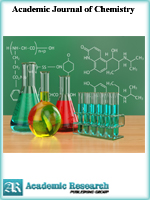Academic Journal of Chemistry
Online ISSN: 2519-7045
Print ISSN: 2521-0211
Print ISSN: 2521-0211
Quarterly Published (4 Issues Per Year)

Archives
Volume 2 Number 1 January 2017
Hydrogen Production Using Mediterranean Sea Water of Benghazi Shore and Synthetic Sea Water Electrolysis
Authors: Imperiyka M. H. ; Rahuma M. N. ; Iman E. A.
Pages: 8-15
Abstract
Hydrogen production has attracted large attention due to depletion of fossil fuels and the threat of global warming, society. This research is concerned with overcoming the problem of efficient production of hydrogen at room temperature and uses it as energy storage and clean fossil fuel alternatives. The hydrogen production was measured from chemical solution such as sodium chloride and natural solution as sea water. Hoffmann voltmeter was used to estimate the production of hydrogen on sodium chloride and sea water at different applied potential 12, 9, 7.5, 6, 4.5, 3 and 1.5 volts and 1 Ampere for 2 hours. The following techniques pH meter and conductivity meter were used to investigate the effect of concentration of aqueous solution on volume of hydrogen gas produce of samples. In general, the production of hydrogen increased by increasing in voltage.
Preparation, Characterization and Flame Retardancy of Expandable Graphite Modified By Ferric Hydroxide. Part II? Flame Retardation and Its Interaction with Ammonium Polyphosphate for Polyethylene
Authors: Xiu-yan Pang ; Wei-shu Chang
Pages: 1-7
Abstract
The influence of expendable graphite (EGFe) modified by ferric hydroxide and its interaction with ammonium polyphosphate (APP) on combustion behavior and thermal stabilities of linear low density polyethylene (LLDPE) were investigated. Results showed EGFe presented better flame retardation than the normal expandable graphite (EG). A 30 wt% EGFe improved the limiting oxygen index (LOI) of LLDPE from 17.6% to 28.1%. Furthermore, the combination between EGFe and APP improved the LOI of 70LLDPE/20APP/10EGFe to 31.6%, and the vertical combustion UL-94 level reached V-0. EGFe and APP were both beneficial for the improvement of composite thermal stabilities, and there was synergistic performance between them which had been testified by the LOI results. Union between EGFe and APP was of benefit for the formation of continuous and compact char layers, which makes 70LLDPE/20APP/10EGFe composite show better flame retardation than the independent 70LLDPE/30APP or 70LLDPE/30EGFe composite.



